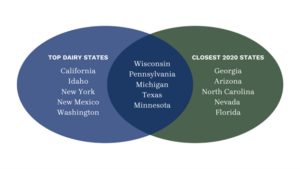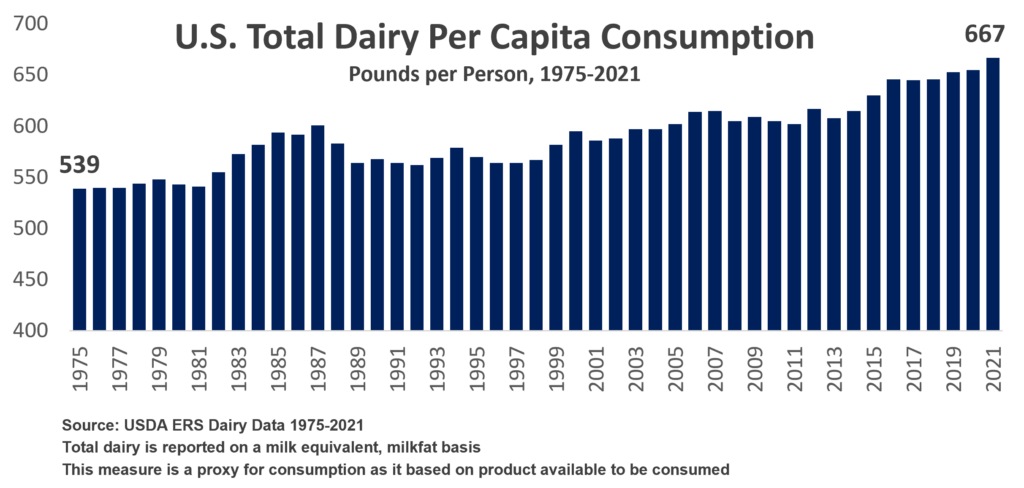Note: These remarks are adapted from NMPF President & CEO Gregg Doud’s remarks at NMPF’s annual meeting in Phoenix, Oct. 22, 2024.
In reflecting on where we were a year ago in this industry, it wasn’t very pretty in terms of prices. There wasn’t a lot of optimism. We have experienced several stressful headlines and considerable market risk in the last year, but look at where we are now. The situation has greatly improved — but there is still work to be done.
Let’s start with the long-overdue update of USDA’s Federal Milk Marketing Orders. Then there is the ongoing revamp of the Cooperatives Working Together program (yes, we need to come up with a new name) to make our dairy exports more competitive. We didn’t sign up for H5N1, but it’s here, and we have to deal with it. The Farm Bill, the Dietary Guidelines and ongoing efforts regarding trade issues – they have all been big challenges this year and we cannot let our guard down for a minute in the months ahead. Importantly, we have a tremendous team in Washington. They are rock solid and up for the task.
And that’s critical in areas such as Federal Milk Marketing Order modernization. As I was just coming on board, I went to a couple of the hearings in Carmel, IN. And although I’m an ag economist, it gave me a headache. What a challenging conversation. But what I also saw was the unbelievable expertise and leadership of numerous NMPF members. Our unanimous message made all the difference. It forced the government to listen.
We’ve seen similar impressive accomplishments on Capitol Hill as well. Late last year we had one of the most interesting votes I’ve seen in 32 years in Washington, when the House of Representatives voted 330 to 99 to put whole milk back in schools. This was a situation where some good old-fashioned shoe-leather lobbying, where you sit down with a member of Congress and say, ‘This is the science. This is the better product. We need to put whole milk back in schools.’ The result was that a majority of both Democrats and Republicans in the House, 330 to 99, agreed. Unfortunately, we have yet to be successful in the Senate on this important issue — but the year isn’t over.
I’m not sure when we’re going to pass the Farm Bill. It could be in the lame duck. It could be next year. It could be the year after. Regardless of who is in the White House or Congress next year, the 2025 congressional agenda complicates the Farm Bill legislative process. The next Congress will likely start by navigating issues such as the debt ceiling, budget reconciliation and executive branch nominations. However, the huge issue will be the five-year expiration of our tax code. The “delta” or difference in terms of the Farm Bill and what we’re debating over is about $10 billion when it comes to reference prices. My understanding is, if Congress does nothing in 2025 on taxes, on Jan. 1, 2026, the tax bill for everyone in this country goes up by $5 trillion. This will be the first big debate of the next Congress and, for the farm economy, it dwarfs any other issue. A reasonable expectation is that this discussion will consume the first half of next year, leaving the Farm Bill debate for the last half of the year, squeezed between the process of approving appropriations bills.
We also have to continue to pay close attention to H5N1. Sometimes when we make investments in animal disease preparedness, we’re not sure if the event will ever actually occur. One of those investments, via the checkoff, we made a while back was in terms of foot and mouth disease, and people said, ‘We haven’t had that in nearly a hundred years, why are we investing in that?’
In reality, this little bit of foresight paid huge dividends this year. When H5N1 hit, we pulled these biosecurity plans off the shelf, we adapted them to this virus, and we plugged them in for a webinar for 1,300 people in this industry, in three days — an unbelievable accomplishment. When we look back to the lessons learned on H5N1, this initial investment, and the subsequent on-farm biosecurity implementation efforts that were a result, made a big difference. We must continue to look around the corner to determine what new investments must be made to ensure we’re ready for the next event, whatever that might be.
On the regulatory side, we’ve been investing in the fight against plant-based beverage mislabeling, and we’ve been proactive on the Dietary Guidelines and other nutrition issues. The team effort with incredible dairy nutrition research coming from the checkoff side, along with numerous industry partnerships along the way has been terrific. We’re going to continue to make our case respectfully, but we are not going to give an inch.
We continue to lead and innovate with improvements in our FARM Program and the ongoing work with the U.S. Dairy Export Council on these always thorny trade issues must be a priority to improve the demand environment for U.S. dairy, domestically and internationally.
This industry has a tremendously bright future. There’s never been a year like this year, in terms of headline risk in the agricultural commodity business. My contemporaries talk about this all the time with wars, inflation, viruses, et cetera. Yet, despite all of this, dairy farmers have persevered and had a tremendously successful year. Our future success will also come from the roughly $7 billion in new processing investments now being made in this industry. This is an investment in you, the dairy farmers of this great nation, and for good reason!
It has been an honor to be a part of the NMPF team in Washington this past year, and I look forward to working with you, and fighting for you in Washington, going forward.

Gregg Doud
President & CEO, NMPF








